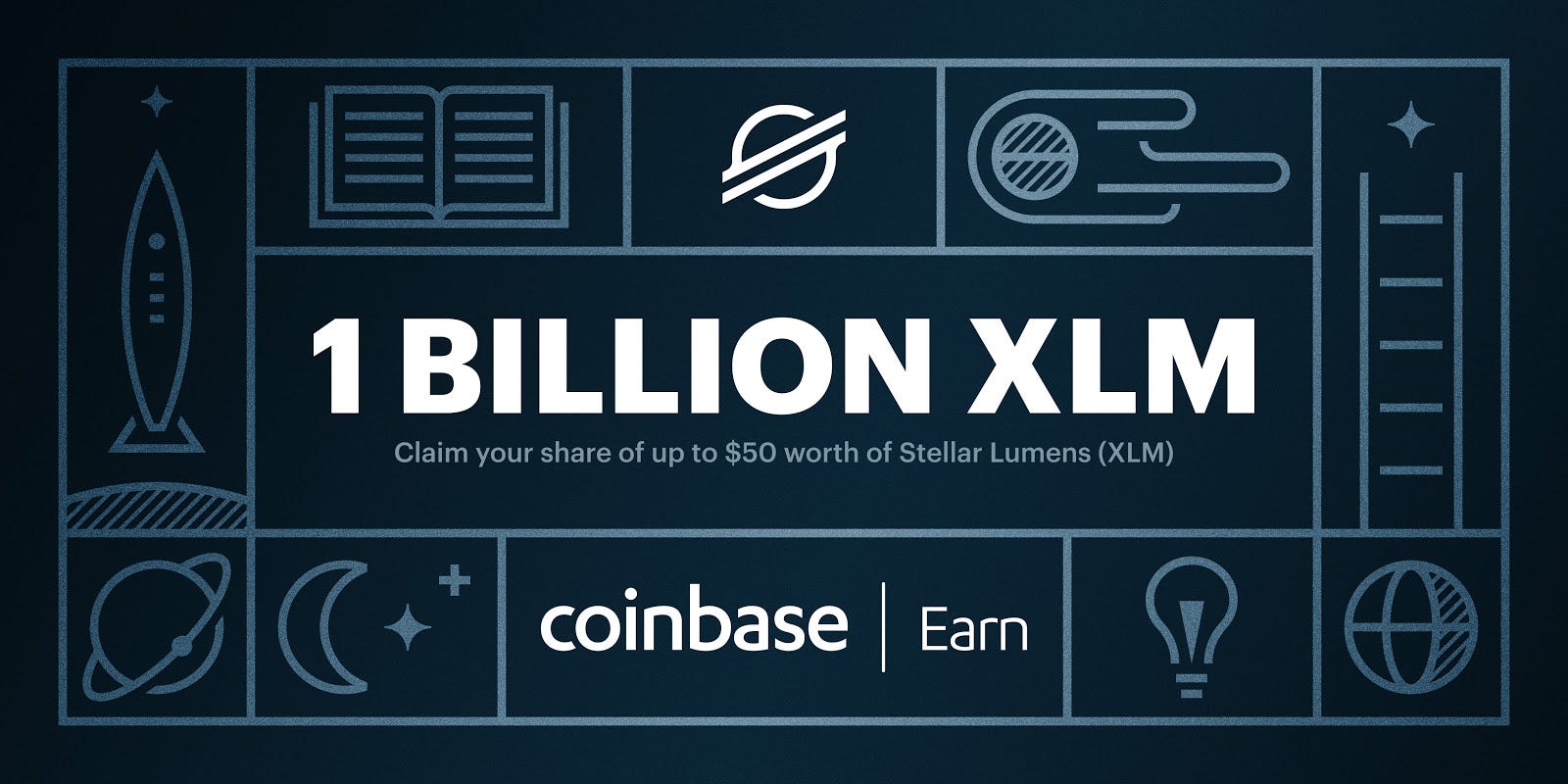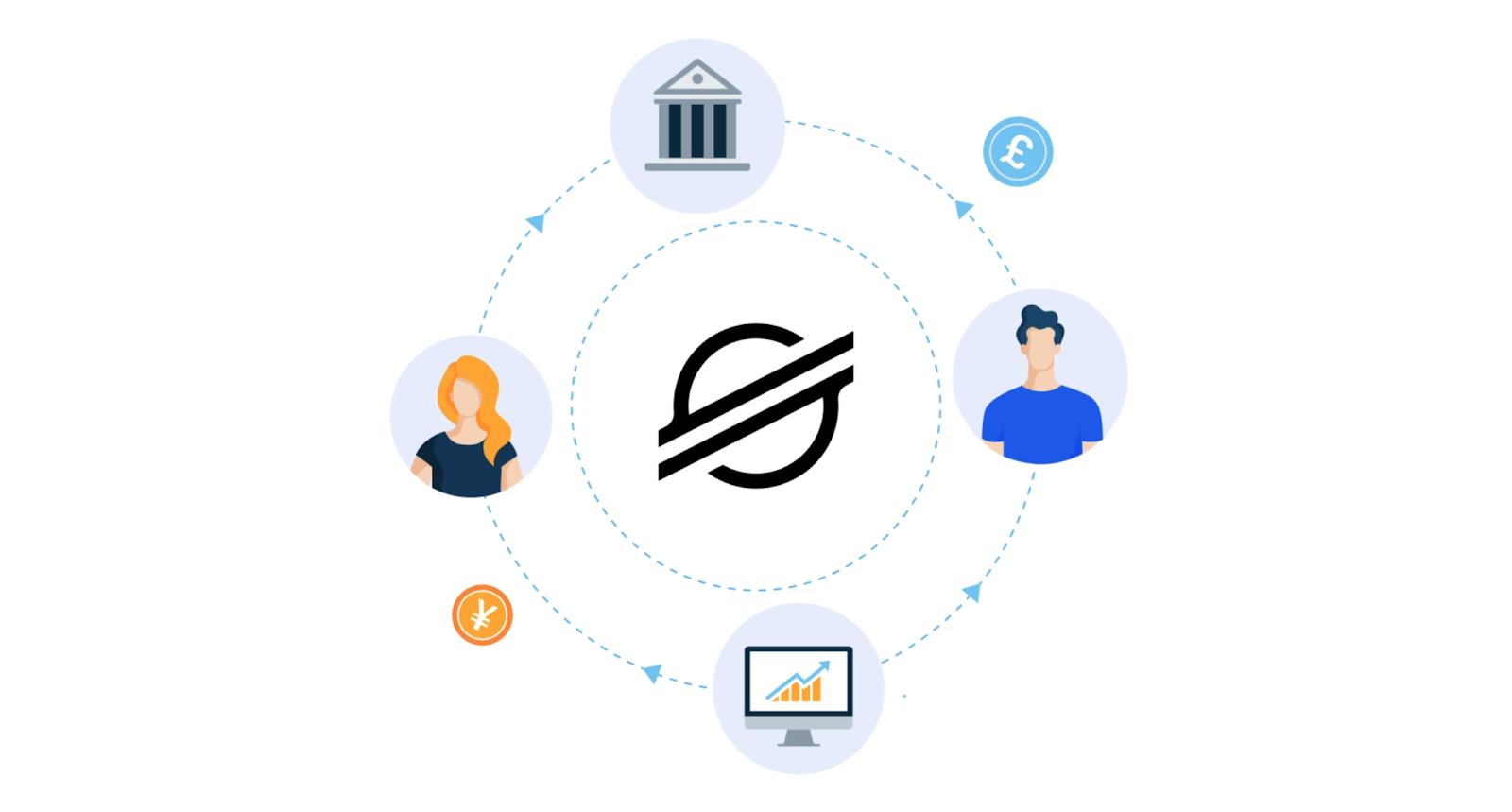Coinbase Earn is giving out one billion Stellar Lumens (XLM) from the Stellar Development Foundation to millions of eligible users to teach them about the Stellar protocol.

Today, we are excited to announce our newest Coinbase Earn opportunity, Earn XLM.
Eligible Coinbase customers in the US will receive an email invitation over the next few days to earn up to $10 of XLM by viewing Stellar tutorials and answering quiz questions. By sharing their unique referral link, customers will also be able to earn up to $40 more of XLM by inviting four eligible friends to complete the lessons.
If you are an international customer or you haven’t received an email invitation yet, don’t worry! You can still view all content on the page for free, and you may join the waitlist to be notified once earning opportunities become available to you.
Up to one billion XLM will be distributed in the Earn XLM opportunity, 100% of which will go towards our customers. These funds are being provided by the Stellar Development Foundation (SDF), a nonprofit organization that helps develop the Stellar protocol.
About the Stellar Protocol

After you participate in the Earn XLM opportunity, you can begin experimenting with the Stellar protocol. Stellar is a platform that aims to connect banks, payment systems, and people more efficiently than today’s financial infrastructure. It does that by facilitating the issuance, exchange, and transfer of tokens — including those that represent real assets, like dollars and euros.
The Problem
Today’s global financial infrastructure has a communication problem. There are hundreds of different currencies and payment systems. Each one of these payment systems speaks a different language, so they have a hard time understanding each other. This can make moving money around the world slow and expensive.
Stellar is a protocol designed to solve this problem. Since it was first launched in 2014, the goal of Stellar has been to unite the world’s financial infrastructure so that money can flow quickly and cheaply between banks, businesses, and people.
How Stellar works
If the Internet connected the world’s computers to enable the free global flow of information, Stellar aims to do the same for money. To accomplish this vision while maintaining neutrality, Stellar is not set up as a bank or a business. Instead it’s a decentralized, open network that is supported by a nonprofit foundation called the Stellar Development Foundation (or SDF for short).
As a decentralized financial network, no single entity can process transactions or stop someone from onboarding or offboarding into Stellar, and the network can still run successfully even if some servers are turned off or fail.

Stellar Lumens (XLM)
The lumen — also known as XLM — is the native asset of the Stellar network.
Lumens can be used for sending money to people overseas or as a bridge currency between tokens on the Stellar network. An account must also hold a small stake of lumens for every other Stellar token it holds. Because it’s blockchain-based, people can hold the XLM cryptocurrency locally on their laptop or phone even if they lack a bank account.
The lumen also serves as a kind of universal translator between each currency supported by the network. This allows banks, businesses, and people using Stellar to send any currency quickly and cheaply across borders. It works because Stellar has a decentralized exchange built into the protocol.
As an example, if one user wants to send dollars to another user who wants yuan, the Stellar protocol can route a payment in US dollars through its order books so it comes out on the other end as Chinese yuan automatically. Under the hood, Stellar can convert yuan to dollars directly, or, if it’s more efficient, use lumens in the middle. This happens in around 5 seconds and for a fee of one ten-thousandth of a cent. The key requirement is that sufficient liquidity in dollars and yuan be available on the network.
In addition to serving as a universal currency translator, lumens also protect the integrity of the network by preventing spam. Transaction fees are paid in lumens, and every Stellar account must maintain a minimum balance too. The transaction fees and minimum balance are low enough that legitimate users don’t really notice them but are high enough to keep spammers from becoming a nuisance.

Stellar for developers
The Stellar network has a particular focus on making it convenient for developers to execute rapid transfers of currency between businesses, to integrate with a variety of different payment systems, and to tokenize existing assets and currencies such as US dollars and euros. Stellar has also tried to make it easy to issue new cryptocurrencies and tokens, and to move them over the Stellar network. In this fashion Stellar has been built to transport both traditional fiat assets and de novo digital assets.
At the core of the Stellar network is a ledger to track these tokenized assets. Like a traditional ledger, the Stellar ledger is a list of all the balances and transactions belonging to every single account on the network. Copies of the global Stellar ledger are hosted on each server that runs the Stellar software. Any entity or person that wants to set up a validator in the Stellar network can do so, though other actors in the network will also need to accept them as validators.
These servers form the decentralized Stellar network, allowing the ledger to be distributed as widely as possible. The servers sync and validate the ledger via the Stellar Consensus Protocol, an algorithm which ensures that transactions are valid and get applied successfully to the global ledger.
For example, if you want to send a $5 payment to your friend on the network, the majority of the servers will have to agree that you do in fact own $5 of credit on the network before they will mark the transaction as valid. This process of coming to consensus on the Stellar network occurs approximately every 2–5 seconds.
Summary
Coinbase’s mission is to create an open financial system for the world. We believe this is the highest leverage way to bring about more economic freedom, innovation, efficiency, and equality of opportunity for everyone. Stellar’s goal of connecting banks, payment systems, and people more efficiently than today’s financial infrastructure is an example of how crypto can help achieve this vision.
Along these lines, Stellar aims to make it possible to quickly and efficiently issue, exchange, and transfer money in a new way. The Stellar Lumen (XLM) — the native asset of the Stellar network — acts as a universal translator between each currency supported by the Stellar network, aiming to allow people and companies using Stellar to send any form of currency quickly, cheaply, and globally. You can read more about Stellar on Stellar.org or on Coinbase.com.
All links to third-party websites are for convenience and informational purposes only (“Third-Party Sites”). Coinbase is not responsible for the content of any Third-Party Site, and the inclusion of any link does not imply endorsement, approval or recommendation by Coinbase.